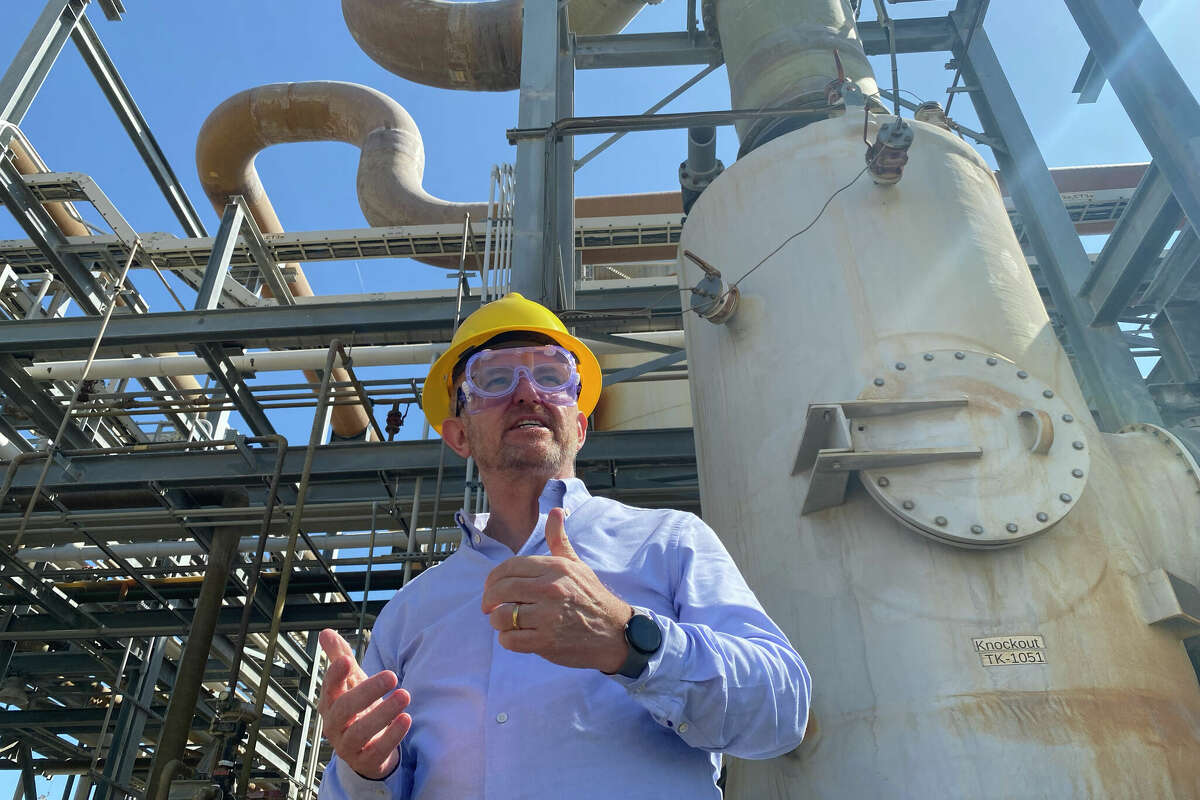
CarbonFree CEO Martin Keighley gives a tour of its plant in San Antonio.
CarbonFree has been capturing carbon dioxide since before carbon capture was cool.
Since 2016, the company has captured flue gas from a cement plant in San Antonio, turning 50,000 metric tons of carbon dioxide into baking soda yearly. The so-called Sky-Mine produces three other valuable chemicals, including chlorine for the San Antonio Water System, and made more than $40 million in profit last year from a $150 million plant.
Despite the hard-earned profits following years of perfecting their process, Carbon-Free’s executives say they have a whole new plan. Because, as any innovator will tell you, doing something hard often teaches you how to do the same thing easier, a vital axiom to remember as carbon capture turns into a trillion-dollar global industry.
“There are a lot of other carbon capture technologies out there that are doing different things,” CarbonFree CEO Martin Keighley told me. “But they’re not doing what we are doing. Our patents don’t overlap or infringe on what they’re doing. We are operating in a clean white space.”
Most climate scientists agree that to avoid climate change’s worst impacts, we must capture carbon emissions — a field known as carbon capture, utilization and sequestration, or CCUS. Some companies capture carbon for other uses, such as making cement or jet fuel, though those sometimes re-release the carbon. Many have the technology to capture carbon and permanently store it.
CarbonFree’s second-generation technology, known as SkyCycle, is the only method that can do both, according to Joe Jones, the chemist who invented the processes and is chief technology officer. SkyCycle can turn captured carbon into limestone blocks to refill old quarries or purify it into precipitated calcium carbonate, a specialty chemical that sells for more than $800 a ton.
A simple explanation for a patented chemical process is that SkyMine uses road salt to turn carbon dioxide into baking soda and three other chemicals with industrial uses. SkyCycle, which took 12 years longer to develop, uses magnesium and calcium to capture the carbon and produce precipitated calcium carbonate and hydrochloric acid.
“Our entire process is carbon negative,” Jones explained.
The real competitive advantage, though, is the $8 billion market for precipitated calcium carbonate. PCC is used to whiten paper, strengthen PVC pipes, make antacids more effective and improve food’s flavor.
Today, PCC is made by cooking limestone in a cement kiln to separate the pure calcium from the carbon dioxide stored in the rock. Companies typically release three tons of CO2 for every ton of PCC they make, creating a massive carbon footprint for their customers.
“We’re displacing three tons, and we’re capturing 0.75 of one ton,” Jones added.
The best part, Keighley said, is CarbonFree charges their customers nothing to capture their emissions. The company makes a profit solely from selling the chemicals it produces, and federal tax credits are the icing on top, allowing it to expand more quickly.
“It’s a great combination of both doing great stuff for the planet but also running a successful, profitable chemical business,” he said.
CarbonFree signed a memorandum of understanding to build the first SkyCycle facility at a U.S. Steel plant in Gary, Ind. The initial modular design is expected to capture 50,000 metric tons of CO2 per year, equivalent to nearly 11,000 passenger cars, Keighley said.
The steelworks is precisely the kind of client Keighley wants, a facility that has no alternative but to emit some CO2. He said the company aims to capture 10 percent of the emissions from so-called hard-to-abate sites by 2050.
CarbonFree offers several critical lessons for industry and the public. Jones could only take his process from the lab table to the field thanks to a Department of Energy grant in 2009. Without the grant, he could never have raised the money to test his theory on a commercial scale.
Second, fighting climate change does not have to hurt economic growth or jobs. Carbon-Free’s plant in San Antonio employs 50 people, and companies such as oil giant BP are investing in what could become a profitable, global business helping to save the planet.
Lastly, dedicated scientists continue to invent previously unimaginable technologies. In looking for an element on the periodic table that can efficiently capture carbon, Jones developed a process to mitigate emissions from another industry.
The next time someone says humans can’t do something, think about CarbonFree, turning CO2 into practical and profitable products.
Chris Tomlinson, named 2021 columnist of the year by the Texas Managing Editors, writes commentary about money, politics and life in Texas. Sign up for his “Tomlinson’s Take” newsletter at HoustonChronicle.com/ TomlinsonNewsletter
